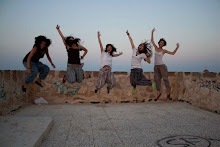“And they said, Come, let us build us a city and a tower, whose top may reach unto heaven, and let us make us a name.” – Genesis 11:4
During the first weekend of the Guardamar studio, me and my
roommate, Cindy, went to Barcelona. Without any doubt, the highlight of our
trip to Barcelona was seeing the work in progress, that is Sagrada Familia, the
final unfinished masterpiece by Antoni Gaudi.
A little bit of its history
first: Gaudi started his work on the church in 1883, and worked until his death
in 1926. At that time, only about 20-25% of his work was finished. Gaudi
dedicated his life to this church so much that he lived inside this church when
it was built. Unfortunately we lost one of the most talented architects because
of the tram accident.
Since then, the construction of the church was funded through
donations. But in present time, I think some of it is funded through the
tourist’s admission tickets. Gaudi never had any blue prints of the church, as
he designed it as it was constructed, leaving future architects to interpret
Gaudi’s work in multiple perspectives through his drawings and instructions. It
was meant to be the work of generations, and, with modern fabrication
techniques and technologies, it was planned to be completed in 2026, the 100th
anniversary of Gaudi’s death.
I had looked forward to see the basilica, being one of the most
mesmerizing buildings in the world. I held my breath as we walked up from the
underground metro station. I first anticipated that I would see a gigantic
church greeting me once I’m outside the station. But the first thing I saw was nothing. Where’s
the church? I thought that it was not as near as I thought it would be, so
we probably had to walk a bit. I was wrong. Haha. As I turned around, there it
was. Big. Beautiful. But cranes – cranes, scaffolding, safety screens, and other
construction stuff. But still, it is something that you’ll never forget.
The church was covered with these beautiful
sculptures – telling the story of Jesus. Gothic on one side – which is the
Nativity façade (first façade to be completed, dedicated to the birth of
Jesus), and kind of a cubist style facade
on the other side – Passion façade (the suffering of Christ).
Since this is the first façade Gaudi completed,
it has this Gothic style to it. It portrays Gaudi’s naturalistic style, as the
sculptures are decorated with images from nature, and animals.
In contrast, the Passion façade is more austere,
plain and simple, with angular cuts and harsh straight lines to resemble a
skeleton. Intended to present the sins of man, and the brutality of Christ’s
sacrifice, Gaudi wanted this façade to have rigid, angular forms to create a
dramatic effect.
So yes, it is all that. It’s amazing.
I read on some commenters on Barcelona travel sites, that it’s not worth it to
pay 13 euros to go inside. It is totally worth it, and I’d recommend the
audioguides.
The columns are a genuine, unique
Gaudi design. It is meant to mirror the trees and branches. In some way, it is
similar to art nouveau style, but I think that Gaudi’s work of art is beyond
that. The interior is rich with ornamentation, complimented with abstract
shapes.
The details are simply inspiring and amazing.
It is truly a work of centuries. A total work of art.
- Anna Phe







No comments:
Post a Comment